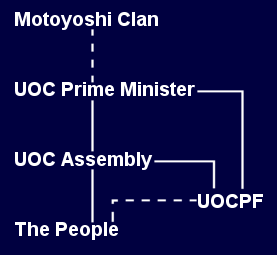Table of Contents
Government of the United Outer Colonies
The government of the United Outer Colonies consisted of a democratic elected assembly lead by a Prime Minister under the symbolic oversight of a monarchy. The government was operated within the confines of a uncodified constitution; uncodified refers to the fact that there are other documents than the primary document which are considered part of the constitutional foundation. It existed from YE 30 until approximately YE 33.
The Government in Roleplay
The Structure of the Government
The governmental system of the United Outer Colonies was simple but effective. The people elected the assembly, with one representative coming from each of the electoral regions of the nation. The assembly then selected a panel of candidates for the position of Prime Minister. The Prime Minister was then selected from the panel of candidates by the Monarch and is then confirmed by the assembly. The Prime Minister became the head of the assembly and together they ratify the legislation of the nation.
The Prime Minister and the Assembly also provided oversight for the United Outer Colonies Peacekeeping Forces which serve the people by providing them with a protective and peacekeeping force.
Constitution and National Foundations
Components of the Government
The Monarchy
The primary function of the Monarchy was to be a symbolic figurehead to the United Outer Colonies.
Crowned Prince Motoyoshi Tio tended to be very active in the government proceedings. He served as an adviser to the Prime Minister and the rest of the assembly. He tended to be very proactive in regards to relations between the United Outer Colonies and other nations in known space. He was proficient in writing treaties and legislations in which he submitted, defended and modified to gain the assembly's approval. While not having a vote, he ensured that the constitution was followed and that the needs of the people were met quickly and efficiently.
It was his duty to select from the panel of selected candidates, proposed by the elected assembly, to select the Prime Minister.
The Prime Minister
The Prime Minister of the United Outer Colonies functioned as the head-of-state and leader of the elected assembly. The responsibilities of the Prime Minister were defined in Articles 23 thru 26 of the constitution. The Prime Minister had a two year term, and can have unlimited terms.
In the assembly the Prime Minister could propose, modify and vote on legislation. The PM also held an additional vote to break a tie vote. The Prime Minister in combination with support of the Crowned Prince could veto any decision made by the assembly.
The Prime Minister was Tange-Katsura Ayana who took office in YE 30 and went missing during the blackout proceeding the NMX invasion.
The Elected Assembly
The members of the elected assembly were voted into office by the constituents of their electoral region. On matters of legislation they had the power of a single vote. It was their duty to submit, modify and vote legislation that were for the benefit of the people, and through polling referendum can be removed from office if their constituents feel they are no meeting their obligations. Their term was two years like the Prime Minister.
| The Assembly | ||||
|---|---|---|---|---|
| System Component | Name of Representative | Year Elected | ||
| Capital Region: Jiyuu System | Shuji Iga | YE 30 | ||
| Region 1: Shugosha System,Siren System,Koukotsu System | Nosaka Mamami | YE 30 | ||
| Region 2: Gensou System, Yuujou System | Alexander Romani | YE 30 | ||
| Region 3: Kotoku System,Tange System,Miyamae System | Arnold Fritz Jr. | YE 30 | ||
| Region 4: Yuukan System | Shinichi Deguchi | YE 30 | ||
| Region 5: Mitsuya System,Asura System | Mochizuki Ayumi | YE 30 | ||
| Region 6: The Lorath Matriarchy | TBA | Protectorate adviser/No Vote | ||
Open Sessions
Citizens were welcomed and encouraged to participate in open sessions of the assembly. Citizens were permitted to register to bring their concerns, wishes and opinions to the Assembly. The amount of time permitted was determined by the Prime Minister.
Legislations (YE 30)
Proposed Legislations
Spirit of Taiie War Orphan Act Fair Work Compensation Act Discussion -Relations with Yamatai Discussion - Removing Vagueness from the Law (defining homicide and establishing a criminal justice system
